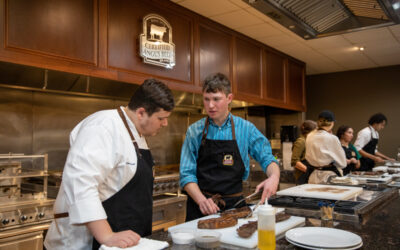
Increasing the odds for beef
by Miranda Reiman
You have to eat it. That’s really the only way to know if a steak is going to be good or not.
So it is with all “experience goods.” Wine and beauty products are other examples.
That’s why it is so important to have a system in place that helps predict product performance, says Daryl Tatum, Colorado State University meat scientist.
The wine industry has its ratings and flavor descriptions and the beef community its quality grades.
In a new research review, “Recent trends: beef quality, value and price,” Tatum combined the results of several studies to provide a comprehensive overview of the grading system’s ability to predict sensory performance and value of beef.
The results say consumers who want more than a “run of the mill” eating experience should reach for premium Choice or Prime.
With Prime, there’s a 97% chance of having a good eating experience, and that is 93% with premium Choice, but low Choice moves to 82%. Select is a “roll of the dice,” Tatum explains, with a one-in-three chance of having a negative experience.

“After sorting for brands, what’s left in the Choice box isn’t too special,” Tatum says, noting that at least a third of the total Choice category is sold in branded beef and premium programs.
Moving up on the grading scale helps improve the odds dramatically. The odds of a good eating experience are 2.9 times greater when trading up from low Choice to premium Choice.
Economic signals reflect that reality.
“Sensory performance does align with the price difference in the trade,” he says.
From 2012 to 2014, the average carcass grid values showed a $13.64 per hundredweight (cwt.) premium for Prime, on down to a $10.09/cwt. discount for Select. Charting those amounts along with the meat sensory measurements shows a linear relationship.
To the grading system critics, Tatum says, “When I look at these things, it seems to be working pretty well. I don’t think we’d have been able to trade beef at the prices we have been without some performance behind it,” he adds.
History demonstrated what happened when marbling wasn’t part of the equation as beef got leaner and the industry tried to compete with other proteins on price alone.

“Demand kept tanking,” Tatum says. “A lot of the quality signals and trends that we see today, began back then.”
He referenced the opposite trends for commodity beef versus the Certified Angus Beef ® (CAB®) brand, which got its start in 1978 and saw dramatic sales increases at a time when beef sales were declining overall.
Yet, much of the early science suggested marbling was not as important in younger animals. One study found it accounted for as little as 10% of the variation in eating quality.
But work done in 2013 shows marbling explains up to 61% of the variation in overall product performance consisting of juiciness, tenderness and flavor attributes.
“Advances in technology and improved methodology have allowed us to uncover some of those relationships and we’re doing a better job of measuring the differences,” Tatum says. From sensory science to instrument grading, there are more tools that add precision to measuring the relationships between marbling and eating quality.
Today’s science is convincing and fits well with the economics, Tatum says. The only way to be sure that an “experience good” is going to give you a good experience is to make use of trusted marketing parameters so that it becomes more of a “search good,” something you seek out repeatedly because of more favorable experiences.
A certain brand, variety and vintage will increase your odds, but, “you never really know until you uncork the bottle,” he says.
Or take that first juicy bite.
To read the entire report, visit www.CABcattle.com/research.
You may also like
Quality Wins, Again
Sara Scott, Vice President of Foodservice for Certified Angus Beef, emphasizes the importance of taste over price in the beef market during the Feeding Quality Forum. As consumer demand for high-quality beef grows, Scott highlights the need for increased supply and encourages communication with packer partners to meet the demand for Prime beef.
Connecting With Consumers at the Meat Case
CAB is committed to prioritizing consumers’ evolving expectations for high-quality beef, sustainability and connecting the next generation. Explore our Ranch to Table program and learn how we connect the next generation of ranchers and culinarians for a brighter, more sustainable future for the beef industry.
Michigan Angus Family Earns Ambassador Award
Seldom Rest Farms in Michigan, known for show-ring success, receives the CAB 2023 Ambassador Award for sharing their beef production story with Meijer grocery communications team and other CAB partners. The Foster family shares their passion for Angus cattle while fostering connections within the beef supply chain and promoting the Angus breed and CAB’s role in the industry.



